Question Number 142514 by mnjuly1970 last updated on 01/Jun/21
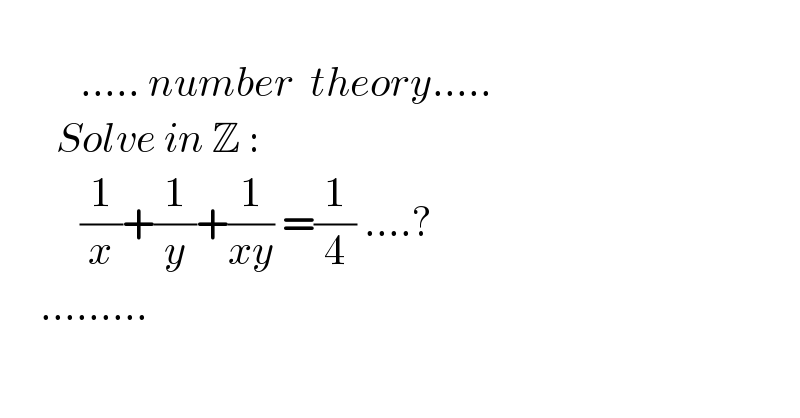
$$\:\:\: \\ $$$$\:\:\:\:\:\:\:\:\:\:…..\:{number}\:\:{theory}….. \\ $$$$\:\:\:\:\:\:\:{Solve}\:{in}\:\mathbb{Z}\:: \\ $$$$\:\:\:\:\:\:\:\:\:\:\frac{\mathrm{1}}{{x}}+\frac{\mathrm{1}}{{y}}+\frac{\mathrm{1}}{{xy}}\:=\frac{\mathrm{1}}{\mathrm{4}}\:….? \\ $$$$\:\:\:\:\:……… \\ $$
Answered by ArielVyny last updated on 01/Jun/21
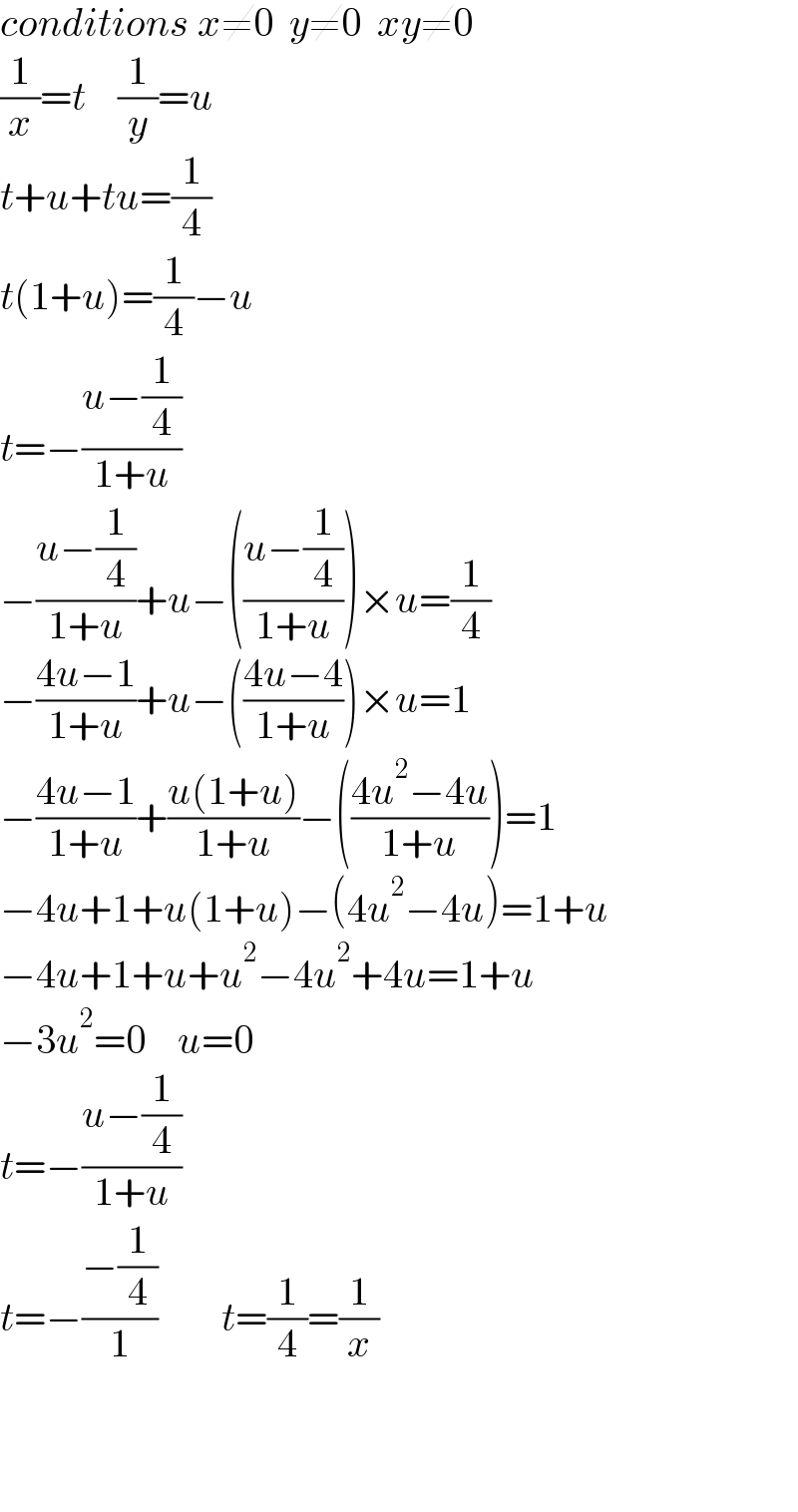
$${conditions}\:{x}\neq\mathrm{0}\:\:{y}\neq\mathrm{0}\:\:{xy}\neq\mathrm{0} \\ $$$$\frac{\mathrm{1}}{{x}}={t}\:\:\:\:\frac{\mathrm{1}}{{y}}={u} \\ $$$${t}+{u}+{tu}=\frac{\mathrm{1}}{\mathrm{4}} \\ $$$${t}\left(\mathrm{1}+{u}\right)=\frac{\mathrm{1}}{\mathrm{4}}−{u} \\ $$$${t}=−\frac{{u}−\frac{\mathrm{1}}{\mathrm{4}}}{\mathrm{1}+{u}} \\ $$$$−\frac{{u}−\frac{\mathrm{1}}{\mathrm{4}}}{\mathrm{1}+{u}}+{u}−\left(\frac{{u}−\frac{\mathrm{1}}{\mathrm{4}}}{\mathrm{1}+{u}}\right)×{u}=\frac{\mathrm{1}}{\mathrm{4}} \\ $$$$−\frac{\mathrm{4}{u}−\mathrm{1}}{\mathrm{1}+{u}}+{u}−\left(\frac{\mathrm{4}{u}−\mathrm{4}}{\mathrm{1}+{u}}\right)×{u}=\mathrm{1} \\ $$$$−\frac{\mathrm{4}{u}−\mathrm{1}}{\mathrm{1}+{u}}+\frac{{u}\left(\mathrm{1}+{u}\right)}{\mathrm{1}+{u}}−\left(\frac{\mathrm{4}{u}^{\mathrm{2}} −\mathrm{4}{u}}{\mathrm{1}+{u}}\right)=\mathrm{1} \\ $$$$−\mathrm{4}{u}+\mathrm{1}+{u}\left(\mathrm{1}+{u}\right)−\left(\mathrm{4}{u}^{\mathrm{2}} −\mathrm{4}{u}\right)=\mathrm{1}+{u} \\ $$$$−\mathrm{4}{u}+\mathrm{1}+{u}+{u}^{\mathrm{2}} −\mathrm{4}{u}^{\mathrm{2}} +\mathrm{4}{u}=\mathrm{1}+{u} \\ $$$$−\mathrm{3}{u}^{\mathrm{2}} =\mathrm{0}\:\:\:\:{u}=\mathrm{0} \\ $$$${t}=−\frac{{u}−\frac{\mathrm{1}}{\mathrm{4}}}{\mathrm{1}+{u}} \\ $$$${t}=−\frac{−\frac{\mathrm{1}}{\mathrm{4}}}{\mathrm{1}}\:\:\:\:\:\:\:\:{t}=\frac{\mathrm{1}}{\mathrm{4}}=\frac{\mathrm{1}}{{x}} \\ $$$$ \\ $$$$ \\ $$$$ \\ $$
Answered by ArielVyny last updated on 01/Jun/21

$${it}\:{is}\:{possible}\:? \\ $$
Answered by ArielVyny last updated on 01/Jun/21

$${i}\:{think}\:{is}\:{not}\:{possible} \\ $$
Answered by ajfour last updated on 01/Jun/21
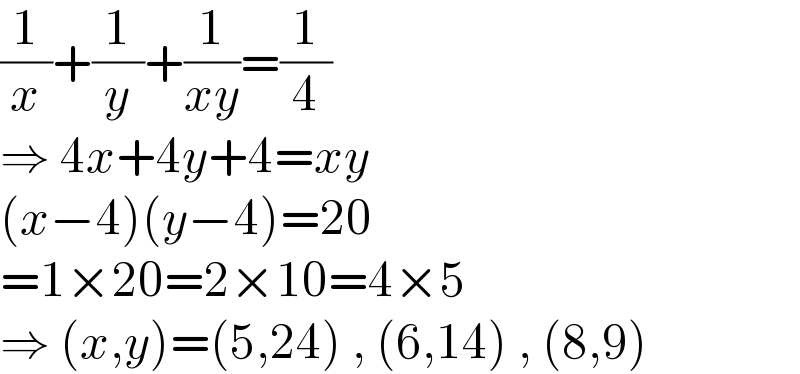
$$\frac{\mathrm{1}}{{x}}+\frac{\mathrm{1}}{{y}}+\frac{\mathrm{1}}{{xy}}=\frac{\mathrm{1}}{\mathrm{4}} \\ $$$$\Rightarrow\:\mathrm{4}{x}+\mathrm{4}{y}+\mathrm{4}={xy} \\ $$$$\left({x}−\mathrm{4}\right)\left({y}−\mathrm{4}\right)=\mathrm{20} \\ $$$$=\mathrm{1}×\mathrm{20}=\mathrm{2}×\mathrm{10}=\mathrm{4}×\mathrm{5} \\ $$$$\Rightarrow\:\left({x},{y}\right)=\left(\mathrm{5},\mathrm{24}\right)\:,\:\left(\mathrm{6},\mathrm{14}\right)\:,\:\left(\mathrm{8},\mathrm{9}\right) \\ $$
Commented by mnjuly1970 last updated on 01/Jun/21
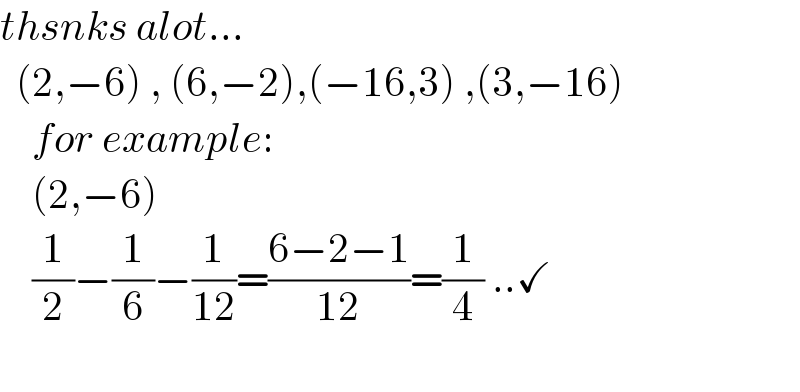
$${thsnks}\:{alot}… \\ $$$$\:\:\left(\mathrm{2},−\mathrm{6}\right)\:,\:\left(\mathrm{6},−\mathrm{2}\right),\left(−\mathrm{16},\mathrm{3}\right)\:,\left(\mathrm{3},−\mathrm{16}\right) \\ $$$$\:\:\:\:{for}\:{example}: \\ $$$$\:\:\:\:\left(\mathrm{2},−\mathrm{6}\right) \\ $$$$\:\:\:\:\frac{\mathrm{1}}{\mathrm{2}}−\frac{\mathrm{1}}{\mathrm{6}}−\frac{\mathrm{1}}{\mathrm{12}}=\frac{\mathrm{6}−\mathrm{2}−\mathrm{1}}{\mathrm{12}}=\frac{\mathrm{1}}{\mathrm{4}}\:..\checkmark \\ $$$$ \\ $$
Answered by mnjuly1970 last updated on 01/Jun/21
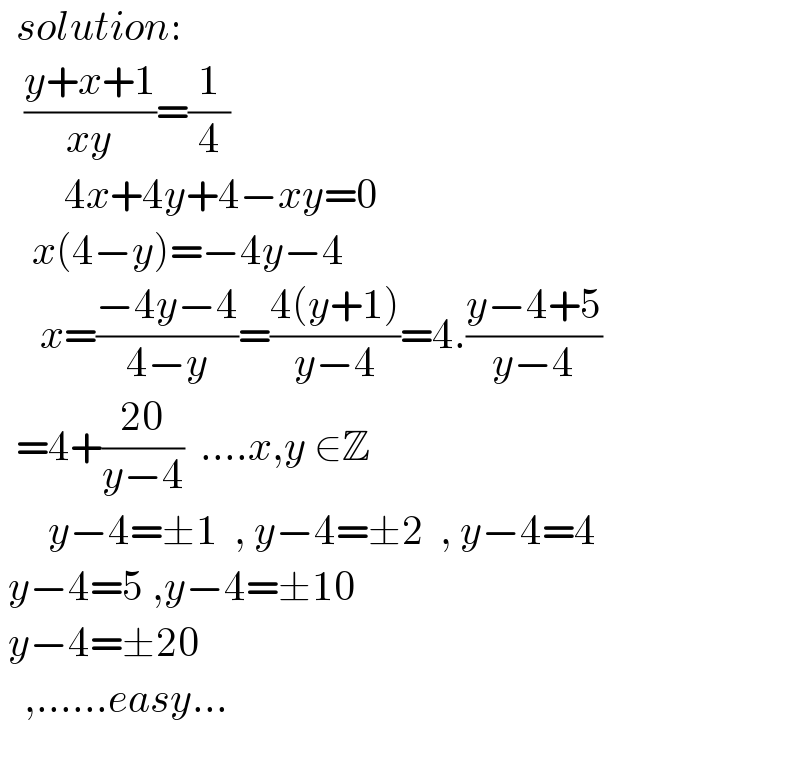
$$\:\:{solution}: \\ $$$$\:\:\:\frac{{y}+{x}+\mathrm{1}}{{xy}}=\frac{\mathrm{1}}{\mathrm{4}} \\ $$$$\:\:\:\:\:\:\:\:\mathrm{4}{x}+\mathrm{4}{y}+\mathrm{4}−{xy}=\mathrm{0} \\ $$$$\:\:\:\:{x}\left(\mathrm{4}−{y}\right)=−\mathrm{4}{y}−\mathrm{4} \\ $$$$\:\:\:\:\:{x}=\frac{−\mathrm{4}{y}−\mathrm{4}}{\mathrm{4}−{y}}=\frac{\mathrm{4}\left({y}+\mathrm{1}\right)}{{y}−\mathrm{4}}=\mathrm{4}.\frac{{y}−\mathrm{4}+\mathrm{5}}{{y}−\mathrm{4}} \\ $$$$\:\:=\mathrm{4}+\frac{\mathrm{20}}{{y}−\mathrm{4}}\:\:….{x},{y}\:\in\mathbb{Z} \\ $$$$\:\:\:\:\:\:{y}−\mathrm{4}=\pm\mathrm{1}\:\:,\:{y}−\mathrm{4}=\pm\mathrm{2}\:\:,\:{y}−\mathrm{4}=\mathrm{4} \\ $$$$\:{y}−\mathrm{4}=\mathrm{5}\:,{y}−\mathrm{4}=\pm\mathrm{10} \\ $$$$\:{y}−\mathrm{4}=\pm\mathrm{20} \\ $$$$\:\:\:,……{easy}… \\ $$$$ \\ $$
